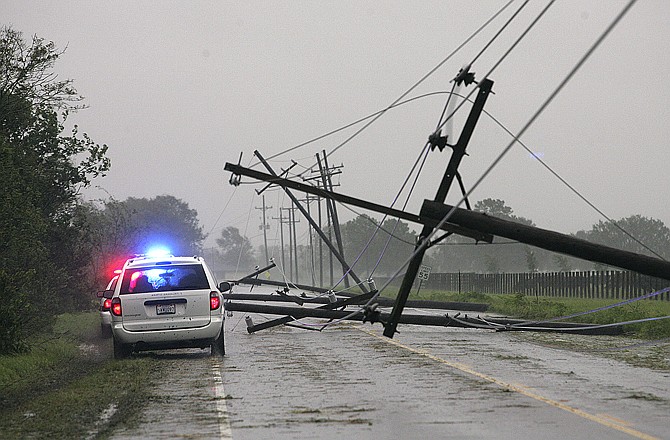NEW ORLEANS (AP) - Hurricane Isaac sidestepped New Orleans on Wednesday, sending the worst of its howling wind and heavy rain into a cluster of rural fishing villages that had few defenses against the slow-moving storm that could bring days of unending rain.
Isaac arrived exactly seven years after Hurricane Katrina and passed slightly to the west of New Orleans, where the city's fortified levee system easily handled the assault.
The city's biggest problems seemed to be downed power lines, scattered tree limbs and minor flooding. Just one person was reported killed, compared with 1,800 deaths from Katrina in Louisiana and Mississippi. And police reported few problems with looting. Mayor Mitch Landrieu ordered a dusk-to-dawn curfew just to be sure.
But in Plaquemines Parish, a sparsely populated area south of the city that is outside the federal levee system, dozens of people were stranded in flooded coastal areas. The storm pushed water over an 18-mile levee and put so much pressure on it that authorities planned to intentionally puncture the floodwall to relieve the strain.
"I'm getting text messages from all over asking for help," said Joshua Brockhaus, an electrician who was rescuing neighbors in his boat. "I'm dropping my dogs off, and I'm going back out there."
By midafternoon, Isaac had been downgraded to a tropical storm. Even at its strongest, it was far weaker than the 2005 hurricane that crippled the city. Because its coiled bands of rain and wind were moving at only 5 mph - about the pace of a brisk walk - the threat of storm surges and flooding was expected to last into a second night as the immense comma-shaped system crawled across Louisiana.
"We didn't think it was going to be like that," Brockhaus said. "The storm stayed over the top of us. For Katrina, we got 8 inches of water. Now we have 13 feet."
Rescuers were waiting for the strong winds to die down before moving out to search for other people.
The extent of the damage was not entirely clear because officials did not want to send emergency crews into harm's way. In Plaquemines Parish, about two dozen people who defied evacuation orders needed to be rescued. The stranded included two police officers whose car became stuck.
"I think a lot of people were caught with their pants down," said Jerry Larpenter, sheriff in nearby Terrebonne Parish. "This storm was never predicted right since it entered the Gulf. It was supposed to go to Florida, Panama City, Biloxi, New Orleans. We hope it loses its punch once it comes in all the way."
The storm knocked out power to as many as 700,000 people, stripped branches off trees and flattened fields of sugar cane so completely that they looked as if a tank had driven over them.
Plaquemines Parish ordered a mandatory evacuation for the west bank of the Mississippi below Belle Chasse because of worries about a storm surge. The order affected about 3,000 people, including a nursing home with 112 residents. In Jefferson Parish, the sheriff ordered a dusk-to-dawn curfew.
After wind-driven water spilled over the levee in Plaquemines Parish, state officials said they would cut a hole in it as soon as weather allowed and equipment could be brought to the site.
The governor said as many as 40 people in the area needed to be rescued.
Back in New Orleans, the storm canceled remembrance ceremonies for those killed by Katrina. Since that catastrophe, the city's levee system has been bolstered by $14 billion in federal repairs and improvements. The bigger, stronger levees were tested for the first time by Hurricane Gustav in 2008.
Army Corps of Engineers spokeswoman Rachel Rodi said the flood-control measures were working "as intended" during Isaac.
"We don't see any issues with the hurricane system at this point," she said.
Isaac came ashore late Tuesday as a Category 1 hurricane, with 80 mph winds near the mouth of the Mississippi River. It drove a wall of water nearly 11 feet high inland.
The storm stalled for several hours before resuming a slow trek inland, and forecasters said that was in keeping with its erratic history. The slow motion over land means Isaac could be a major soaker, dumping up to 20 inches of rain in some areas. But every system is different.
"It's totally up to the storm," said Ken Graham, chief meteorologist at the National Weather Service in Slidell, La.
Slashing rain and wind gusts up to 100 mph buffeted New Orleans skyscrapers.
As hard wind and heavy rain pelted Melba Leggett-Barnes' home in the Lower 9th Ward, an area leveled during Katrina, she felt more secure than she did seven years ago.
"I have a hurricane house this time," said Barnes, who has been living in her newly rebuilt home since 2008. She and her husband, Baxter Barnes, were among the first to get a home through Brad Pitt's Make It Right program.
Her yellow house with a large porch and iron trellis was taking a beating but holding strong.
"I don't have power, but I'm all right," said Barnes, a cafeteria worker for the New Orleans school system.

